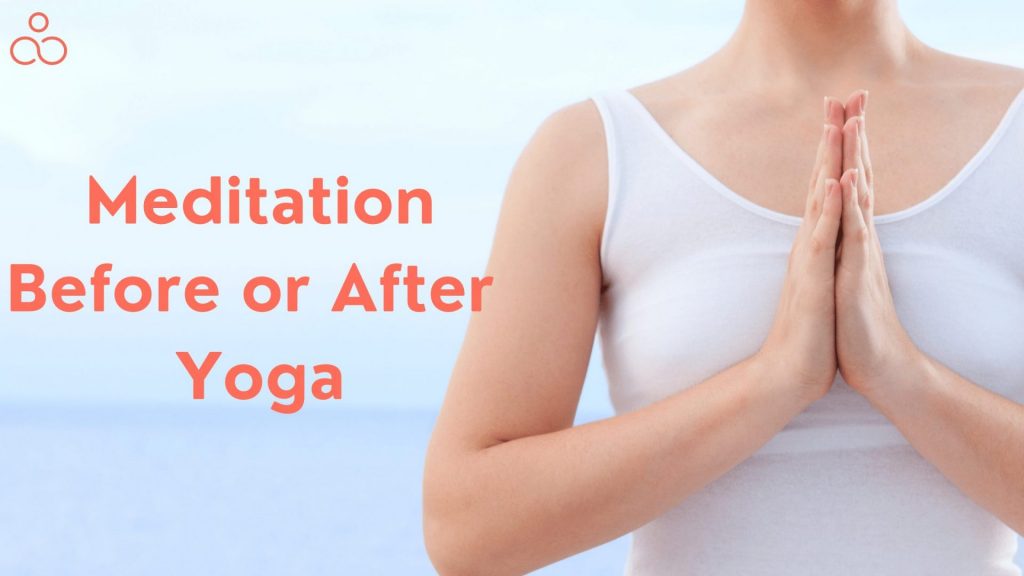Deciding which is ideal for you, meditation before or after Yoga depends on your daily routine and practice timing. Both offer numerous benefits, with Yoga enhancing flexibility and calming the mind, while meditation alleviates depression and anxiety symptoms. Traditionally, Yoga precedes meditation for optimal energy release and preparation for a restful state.
In this article, we’ll examine the perks of both practices along with different meditation styles and Yoga asanas to enhance your practice and guide you in structuring your routine to achieve your objectives.
What is Meditation?
Meditation is the practice of being aware of yourself and your thoughts in the present moment without judgment. Originating from the Latin word “meditation,” it means to think deeply. This practice helps you control your thoughts and detach from reactions, training your mind for mindfulness. Meditation is found in all religions through activities like walking, contemplation, or simple prayers.
Nowadays, meditation is mostly practiced without religious ties. Many mental health professionals use meditation techniques for therapy and training to enhance psychological well-being. Various forms of meditation exist, such as concentrative practices, mindfulness meditation, and mindfulness-based techniques like stress reduction (MBSR) and cognitive therapy (MBCT).
Similar to Yoga, meditation offers numerous mental and physical health benefits. Studies show that it can lower blood pressure, heart rate, and stress levels and improve symptoms of psychiatric disorders like depression and anxiety.
What is Yoga?
Yoga is an ancient practice rooted in Indian philosophy, initially focused on spirituality but has become popular for boosting physical and mental health. Commonly practiced in the US, Yoga focuses on physical postures (asanas), breathing techniques (pranayama), and meditation (dhyana). Yoga, along with Chinese-originated tai chi and qigong, are all considered “meditative movement” practices, combining both meditation and physical aspects.
Studies show that Yoga can be beneficial for many aspects of wellness, including stress management, mental and emotional health, healthy eating and activity habits, sleep, and balance.
Meditation vs. Yoga
| Parameters | Meditation | Yoga |
| Purpose | Primarily focused on mental relaxation, mindfulness, and self-awareness. | A holistic practice that encompasses physical postures, breath control, meditation, and ethical principles. |
| Techniques | Various techniques like mindfulness, transcendental meditation, loving-kindness meditation, and guided meditation are employed to silence the mind. | Offers a diverse range of styles, such as Hatha Yoga, vinyasa Yoga, yin Yoga, and kundalini Yoga which cater to different abilities and preferences. |
| Physical Activity | Most meditation practices involve minimal physical activity, with an emphasis on mental concentration and relaxation. | Yoga is more physically demanding, as it requires strength, flexibility, and balance to perform various poses. |
| Benefits | Reduced stress levels, improved focus and concentration, improved emotional stability, better sleep quality, and enhanced sense of well-being. | Improved flexibility, muscle strength, enhanced respiration and energy levels, weight management, stress relief, and inner peace. |
| Duration | 10 minutes to an hour or more | 45 minutes to 90 minutes |
Should I Do Meditation Before or After Yoga?
Yoga and meditation both offer numerous advantages, including stress relief, enhanced athletic performance, better memory, and improved sleep. However, the order of these practices depends on your objectives.
Many Buddhists practice Yoga to enhance the quality, duration, and comfort of their meditation sessions. Yoga boosts joint health and flexibility, allowing you to sit comfortably during extended meditation periods. It also releases bodily energy, which helps in calming the mind during meditation. Hence, many people prefer doing Yoga before meditation for a deeper experience.
Meditation is also an important part of Yoga practice. Several Yoga styles emphasize breathwork and act as a moving meditation. Meanwhile, other forms, like Yoga Nidra, focus on deep meditation to achieve restful sleep.
Benefits of Meditation Before Yoga
Practicing Meditation is a great way to get ready for Yoga. It helps enhance focus, relaxes the mind, reduces stress, and improves both the physical and mental aspects of Yoga. That’s why many people choose to meditate before doing Yoga, making their meditation even better.
Here are some reasons why meditating before Yoga is good:
Calms Your Mind
Meditation helps to quiet your thoughts, making it easier to focus and be present during Yoga.
Helps You Relax
If you feel nervous or tense before starting Yoga, meditation can help ease your stress and anxiety.
Increases Awareness
Meditating can boost your attention and self-awareness, which will help you pay attention to your body and breath during Yoga.
Boosts Calmness
If you want your Yoga practice to help you unwind and relax, meditating beforehand can create a peaceful and calm mood.
Enhances Overall Well-Being
Research shows that meditation offers health benefits like strengthening the immune system, lowering blood pressure, and reducing anxiety and depression. Meditating before Yoga can improve your practice while promoting inner peace and well-being.
Enhanced Flexibility
Meditation helps release tension and boosts blood flow to muscles, resulting in better flexibility and movement. This allows you to perform Yoga poses effectively while lowering injury risk.
Increased Strength and Balance
Meditating enhances overall strength and balance by promoting mindfulness and attention to your body. Being more aware of your posture, alignment, and muscle use improves strength and balance during Yoga sessions.
Benefits of Meditation After Yoga
Meditation after Yoga is an excellent way to enhance relaxation and inner peace while enjoying the benefits of your Yoga session. Here are some advantages of meditating after Yoga:
Stress Relief
Yoga helps to calm your body and mind, making it easier to meditate.
Better Focus
Yoga aids in developing attention and awareness, making it easier to stay focused during meditation.
Clearer Mind
Yoga reduces mental distractions and clears your mind, allowing for better concentration while meditating.
Enhances Overall Well-Being
Practicing both Yoga and meditation offers numerous health benefits, such as reducing anxiety and stress, improving mood, and promoting a sense of well-being.
Reflective Thinking
Meditation after Yoga allows you to reflect on your Yoga practice and experiences both on and off the mat, leading to a deeper understanding of yourself and your actions.
Reduced Risk of Injury
Combining meditation and Yoga reduces injury chances. Meditation encourages relaxation, reducing the likelihood of muscle strains during Yoga. Focusing on your body and breath also helps you notice any discomfort or pain, enabling you to adjust your practice accordingly.
Keep in mind that there’s no right or wrong way to meditate after Yoga. You can try guided meditation, focus on your breath, or simply sit quietly. Whatever method you choose, let yourself relax fully and be truly present in the moment.
Different Types of Meditation to Incorporate into Your Yoga Routine
There are different types of Yoga that include meditation. You can add various meditation styles to your Yoga routine. Here are some meditation practices, with their types and explanations, that go well with Yoga and can be part of your flow:
Pranayama
Breathing exercises are one of the eight parts of Yoga. There are many techniques in pranayama meditation. Adding controlled breathing to Yoga and meditation helps to calm your nerves, increase focus and relaxation, and reduce stress.
Kundalini Meditation
This type of meditation is used in Kundalini Yoga. This practice involves using breath, posture, and mindfulness to transfer energy from the base of the spine to the rest of the body.
Transcendental Meditation
Created by Maharishi Mahesh Yogi, this technique involves daily mantra meditation. A technique that involves sitting quietly for 20 minutes two times a day and repeating a mantra silently in mind. It helps to calm the mind and improve overall health and well-being.
Yoga Nidra
Yoga Nidra, also called “yogic sleep,” is a practice where you use guided meditation to reach a state of consciousness between being awake and asleep. It has been proven to lower stress and boost mental and physical wellness.
Loving-Kindness Meditation
A practice of sending love and kindness to oneself and others. It involves sitting quietly for 20 minutes twice a day and repeating a mantra silently in the mind. The mantra is designed to generate positive emotions and improve relationships with others.
9 Yoga Postures to Enhance Your Meditation Practice
If you decide to do Yoga before meditating, some poses can help enhance your breathing and posture. These poses help open your chest and lungs and release energy, making it easier for your mind to calm down during meditation.
Prayer Pose
This simple pose involves placing your hands together in a prayer position while seated comfortably. Some people meditate in this pose for a few minutes before Yoga. It helps open up the chest and shoulders, focusing attention on the diaphragm for better concentration.
Child’s Pose
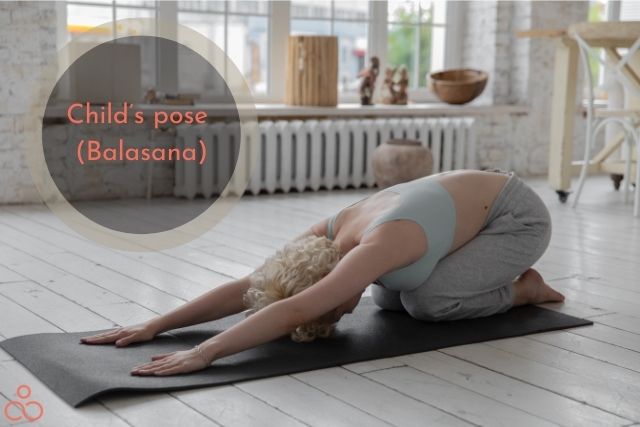
In this relaxing pose, sit on your knees and lean forward, stretching your body over your legs. Your face should touch the mat or floor, and your arms extend in front of you. This pose stretches your back, neck, hips, and shoulders, releasing tension and preparing you for meditation at a low intensity.
Mountain Pose
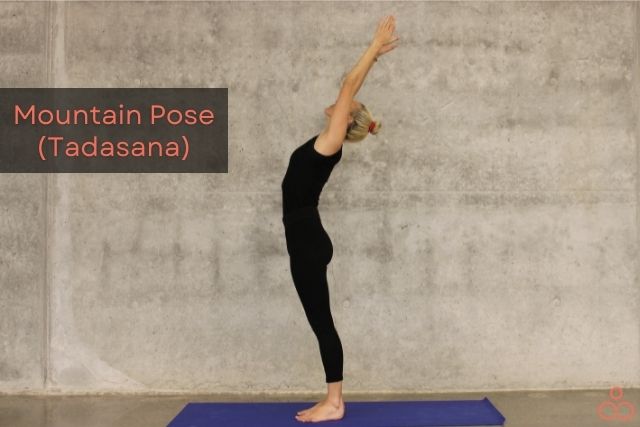
To do this pose, stand up straight with your arms relaxed by your sides. This position is excellent for calming your breath and making your body stronger. It also lets energy move upwards through your body.
Low Lunge
Low lunges are well-known among athletes and runners. To perform a low lunge, put one foot forward, the other foot stretched back, and bend your front knee to tighten your thighs and hips. Low lunges help stretch the hips and make the legs stronger, which can be helpful during long periods of sitting in meditation. Many people hold energy and tension in their hips, so loosening those muscles can increase focus and comfort while meditating.
Tree Pose
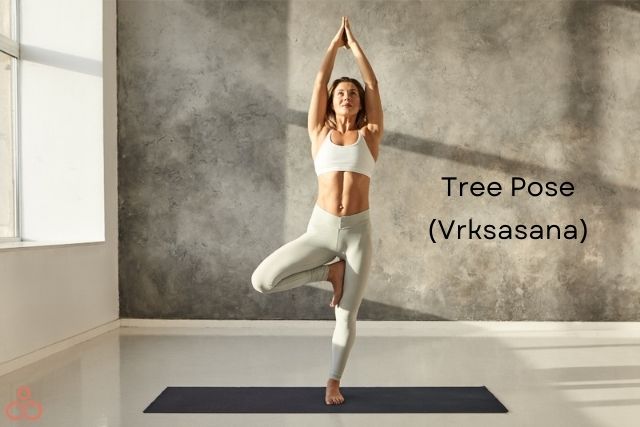
This simple Yoga position helps balance, focus, and open the chest and hips. In this pose, you stand on one foot while lifting the other, placing it either on the ankle, above the knee, or tucked into the upper thigh. This balancing act helps you concentrate during meditation, setting up your mind to concentrate better.
Eagle Pose
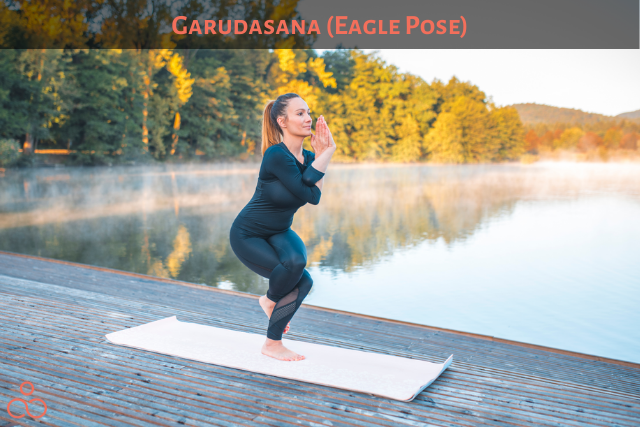
The eagle pose is another balancing posture that includes several twists. It’s a bit tricky to describe, but essentially, you cross both your arms and legs and bend your knees to create a tight knot-like shape. This pose is excellent for stretching your upper back and shoulders, leading to easier breathing. Along with improved focus from balancing and complicated twisting, this pose prepares you for any meditation session.
Dancer Pose
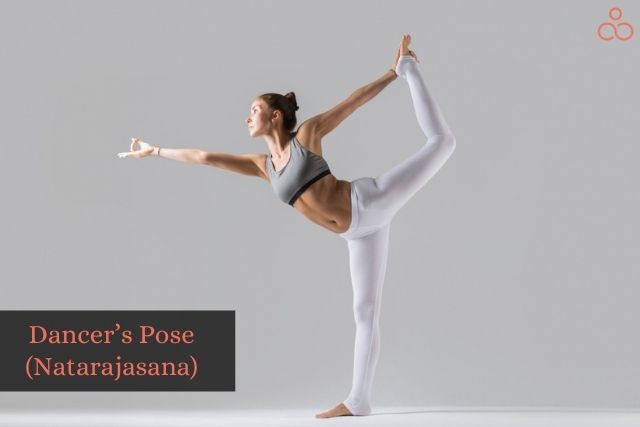
The dancer pose is a balancing posture that stretches and lengthens your body. In this pose, you stand on one leg while extending the other leg behind you and reaching the opposite arm forward. Balancing helps improve focus, and stretching your body releases energy through your head and feet, helping to relax your mind during meditation.
Camel Pose
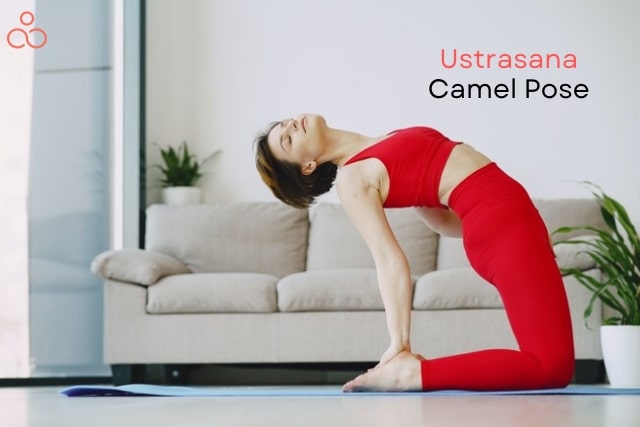
In camel pose, you start by sitting on your knees, then place your arms behind your feet and lift your chest up towards the sky. This pose opens up the chest, allowing trapped energy in the lower body to escape through the head. The deep chest stretch is great for enhancing breathing, back and side flexibility, as well as improving posture.
Corpse Pose
Even though it might seem simple, the corpse pose is important. Lying on your mat after a Yoga session helps calm both the mind and body, allowing your muscles to relax after intense stretching. You can also use the corpse pose as a meditation posture itself – just go straight into meditation right after finishing your Yoga practice.
Health Benefits of Combining Meditation & Yoga
Meditation and Yoga provide many health benefits, including:
Stress Relief
A study by The University of Sussex School of Psychology found that meditators experienced less stress when dealing with conflict. Years of research confirm that daily meditation can lower stress and improve the nervous system’s reaction to stress. Likewise, Yoga has been proven to decrease cortisol levels. In a study, 24 emotionally distressed women saw significantly reduced cortisol levels after practicing Yoga daily for three months.
Eases Anxiety and Depression
Meditation and Yoga also help alleviate anxiety and depression. Studies on patients with PTSD showed that attending Yoga classes a few times a week led to a 52% reduction in symptoms. Both practices lower cortisol levels, affecting serotonin levels in the brain, which directly influence anxiety and depression symptoms. Some types of meditation can also create brain pathways linked to gratitude and optimism, reducing depression symptoms and helping patients better cope with remaining issues.
Enhanced Sleep
Meditation and Yoga can boost not only your daily life but also your sleep quality. A study by the University of Southern California’s Department of Preventative Medicine discovered that daily meditation effectively treated insomnia and sleep issues. In another study with seniors, Yoga outperformed herbal remedies and a control group in terms of sleep benefits. Those practicing Yoga experienced longer sleep times and faster sleep onset. Adequate sleep is vital for our body’s functioning and self-repair, with improved sleep quality leading to better overall health.
Better Physical Health and Performance
As per the Journal of Cognitive Enhancement, meditation can enhance athletic abilities in both closed and open-skilled sports. Closed-skilled sports have a fixed environment, like track and field or gymnastics, while open-skilled sports involve variable settings, such as basketball and soccer. Various meditation types can impact athletic performance differently, potentially giving you a competitive advantage if you aim to improve speed, agility, or skill.
Likewise, Yoga provides physical health benefits like increased flexibility and balance that can enhance athleticism. Yoga can also aid in muscle recovery for athletes.
The Impact of Yogic Knots on Meditation
Kundalini Yoga focuses on overcoming three psychic knots, or grantis, that block our path to enlightenment. These grantis are in the hips, chest, and head, symbolizing various challenges faced by Yogis.
Grantis can interfere with your meditation due to their psychic nature. Kundalini Yoga aims to awaken a life force within your body by clearing each chakra until it reaches your consciousness.
Yoga helps the life force pass through these knots, leading to enhanced mindfulness and mental clarity. The grantis represent different attachments:
- Brahma (hips) – attachment to the material world
- Vishnu (chest/heart) – emotional attachment
- Rudra (mind) – attachment to individual self
Many yogis believe that combining Yoga with meditation releases these energy blockages, allowing the life force to flow freely and improve overall spiritual well-being.
Tips for Enhancing Your Meditation and Yoga Practice
Whether you choose to practice meditation after Yoga or before, seeking improvement already puts you on the right track. Research and experimenting can help discover what works best for you. Focus on achieving tangible results before worrying about enlightenment.
Here are some useful tips for immediate improvement in meditation and Yoga practice:
Personalize Your Space
Regardless of its size, make your space comfortable and unique. Simple steps like tidying up, using candles or incense, or minimizing distractions can make a difference.
Disconnect Any Distractions
Turn off screens, notifications, music, and advertisements, set your phone to silent, and create a peaceful environment that allows you to focus on yourself.
Be Comfortable
Avoid falling into uncomfortable habits. Try a pillow or folded blankets to assist with flexibility issues like lying in bed or sitting.
Meditate at the Same Time Daily
Schedule a specific time each day for meditation and make a promise to yourself to stick to it. This helps you create a consistent habit. Use a timer to stay focused and avoid going over your planned meditation duration.
Start Slowly and Progress Gradually
Meditation is a skill you can develop over time. It’s normal to feel anxious and restless when starting. You’ll eventually learn to control your emotions and prevent them from dominating your thoughts. Begin slowly, be patient, and increase the duration as you grow more comfortable with the practice.
Utilize Apps
Explore free or subscription-based apps for guided meditations and Yoga routines. YouTube also offers free resources to support your practice.
Change Things Up
If Yoga comes before meditation in your routine, switch their order occasionally to keep things fresh and prevent plateaus in progress.
Combine Walking with Meditation
As you improve, try combining walking and meditation. Start with a 15-minute walk, focusing on your breath, your steps, and surrounding sounds. When your mind wanders, return your focus to one of these sensations. This will help you feel more connected.
Mind Your Posture and Breathing
Pay attention to your breathing as well as your posture. A straight spine can significantly impact the quality of your practice. If you notice your mind wandering off, bring your focus back to your breathing and posture.
Stay Consistent
It might take some time before you experience the benefits of meditation. Don’t get discouraged if results don’t come right away. Keep practicing, and the advantages will come gradually. To blend meditation into your Yoga routine, allocate 5-10 minutes daily, ideally during morning or evening hours. This helps maintain a consistent practice. Remember that meditation is personal, so explore different techniques to find what works best for you.
FAQ’s
How soon will I experience the benefits of meditation?
The time it takes to feel the benefits varies based on your practice frequency and dedication. Some people notice improvements in just one or two weeks, while others need an extended period of consistent practice. Stick with it and enjoy the journey of your meditation routine.
Can I exercise after meditating?
Yes, you can. The kind of meditation you pick influences your practice quality and experience. So, it’s beneficial to try different meditation and breathing techniques before and after workouts is beneficial.
Moreover, meditation has a transformative effect on life. Your present goals might differ from future ones, which is entirely normal. Stay open to growth and change.
Should you do Yoga before or after meditation?
The traditional eightfold path of Yoga recommends doing asana before meditation to strengthen and prepare the body for stillness. Practicing Yoga before meditation or after helps release stress and relax both body and mind, setting the stage for effective meditation. The ideal state for meditation is a comfortable, still body and rested mind.
Should I meditate before bed?
Meditation before bed can improve sleep quality as long as you practice a calming and relaxing method. Reflecting on the day’s events with a non-judgmental mindset can cultivate self-awareness and build good habits. However, nighttime meditation may not be suitable for those seeking to enhance focus and alertness.
What is the best time to practice meditation?
Early mornings are typically best for meditation as it sets a positive tone for the day. Mid-day or after-work sessions can also provide relief from daily stress. Traditional Hindu beliefs emphasize early morning hours as the most supportive for spiritual growth and self-development.
However, morning meditation may not suit everyone, and that’s fine. The best time to meditate is whenever it fits your schedule. A post-lunch walk or a late afternoon break can also be perfect times for meditation. Just try to stick to your routine and avoid distractions.
Can I do Yoga and meditation on the same day?
Definitely! Doing Yoga and meditation together is a great way to begin a meditation routine. Both activities help you feel calm and think deeply about yourself, so they work well together. If you’re new to meditation, doing it after Yoga can be even better because it helps to quiet your thoughts and relax more deeply.
Should I stretch before meditating?
Stretching before meditation helps make sitting more comfortable by relaxing and opening up the body. Simple Yoga poses can alleviate potential drowsiness, discomfort, or pain during seated meditation. However, meditating before stretching can also benefit by increasing focus and mindfulness during exercise.
Is it okay to meditate after eating?
It is best to meditate with an empty stomach or wait at least two hours after a meal. Meditating post-meal may cause drowsiness since energy is needed for digestion, hindering your meditation practice. In techniques like Vipassana, practitioners avoid eating after sunset during a ten-day course. Beginners are provided light, simple meals to minimize digestive distractions. However, meditating on an empty stomach may be challenging due to food cravings that affect focus.
Should you do Yoga before or after a shower?
Shower before Yoga for refreshment and focus. Wait at least 30 minutes post-Yoga to shower to let the body cool down. Traditional ashrams in India recommend this practice for optimal results.
Should I meditate before or after my morning run?
Incorporate a short 1-2 minute meditation before your run to stimulate focus, clear your mind, and create breath awareness. Post-run or after sports activities, meditation is just as crucial.
During exercise, the body and mind are active, making decisions, sometimes going on autopilot, leading to changes in heartbeat, pulse, and fatigue. Noticing these changes and stimulating the parasympathetic nervous system through post-exercise meditation is essential for balance.
Conclusion
Yoga and meditation both enhance health and well-being. Combining both of them in your daily routine brings significant results. Choosing between practicing meditation before Yoga or after depends on your goals, but many experts suggest doing Yoga first to boost concentration. There are no strict rules, and as long as you’re growing spiritually, mentally, and physically, you’re on the right track. Even if the progress is small, if it helps you feel better, calmer, kinder, and more focused, there’s no harm in trying different methods.

